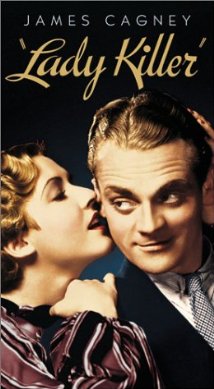
LADY KILLER
US, 1933, 76 minutes, Black and white.
James Cagney, Mae Clarke, Margaret Lindsay, Leslie Fenton, Douglas Dumbrille, Russell Hopton, Raymond Hatton, Henry O' Neill.
Directed by Roy Del Ruth.
Lady Killer is a tongue-in-cheek blend of the gangster film, comedy and glimpse at Hollywood filmmaking. It is a star vehicle for the emerging James Cagney who had already made an impact as a gangster in Public Enemy (and here stars with Mae Clark, the recipient of his group grapefruit in that film but treated far more harshly in this one, dragged by the hair from the room and tossed out, and then literally tossed out of a room in another sequence).
He portrays the smug theatre usher who gets sacked, is picked on by a vamp, Mae Clarke, returning her purse to her hotel room, only to be tricked into a card came and losses. When he realises what has happened, he takes over the gang, and they begin a series of robberies.
When things get too hot, he goes to California, is apprehended by the police, asked to get a job, and catches the attention of film scouts who put him in small parts, then with his own writing his fan letters, he becomes a star.
Needless to say, the gang come to Hollywood, start robbing the homes of the stars, and Cagney is caught trying to return the jewels to Margaret Lindsay, his co-star. He is bailed to become a target, but he is warned by the vamp and there is quite a spectacular chase with Cagney finally vindicated – and continuing his rise to stardom. At one stage, there is a poster and comment on Edward G Robinson as a rising star, already Little Caesar.
1. Entertaining blend of gangster thriller, comedy, look at Hollywood?
2. Warner Bros in the 1930s, the picture of gangster activity, the comic touches with the ultra-smart James Cagney, the satire on Hollywood, the producers wanting stars and tough new faces, the bit parts, filming, especially when stars clashed, fans, magazines, letters? The musical score?
3. Dan’s story, James Cagney at Warner Bros, cheeky personality, gangster roles, song and dance? As an usher, rebellious, chewing gum, making difficulties with the lady and the dog, smart cracks, being fired? Finding Myra’s purse, taking it to the hotel, going in, into the card game, the confrontation, getting his money back, finding the next customer, taking over the racket? Having a club, the clients? The targets, the fake accident, the fake doctor, going into the house, the later robbery? The other members of the gang, Spade and being in charge, Duke and his surly attitude? Myra, the equivalent of the gangster’s moll?
4. The police, the killings, closing in, Dan and Myra going to California, the police apprehending him, his discussions, promising to get a job, wandering around town, the talent scouts, hiring him, the different roles, the Indian, in Lois’s caravan? His writing his own fan mail? The producers wanting new faces, choosing him, his quick rise to fame? His relationship with Lois?
5. The gang arriving, to the hotel, the hold over him, his giving them $10,000, their staying, going on the tour of the stars’ homes, the robberies, the police and their suspicions?
6. Lois, the visit, finding Myra, the clash, the romantic scene and the garlic? Her jewels being robbed, then Dan going to retrieve them, the police catching him with the jewels, in prison? The gang and the bail, Dan;s money, the plan to kill him? Lois and her intention of bailing him?
7. Dan getting out, shrewd, in the car, Myra warning him, his having told the police, the desperate chase, the arrests, his vindication, with Lois, and his future stardom?
8. A variation on the 1930s screwball comedy style?